Aloha, food enthusiasts! Are you ready to take a taste trip to Hawaii? Hold onto your taste buds, because we’re about to explore the mouth-watering world of Hawaiian cuisine. It’s not just about pineapples and coconuts (though they’re great too); it’s a rich tapestry of flavors that’ll make you say, “Wait, I need more of this in my life!”
The Melting Pot of Flavors
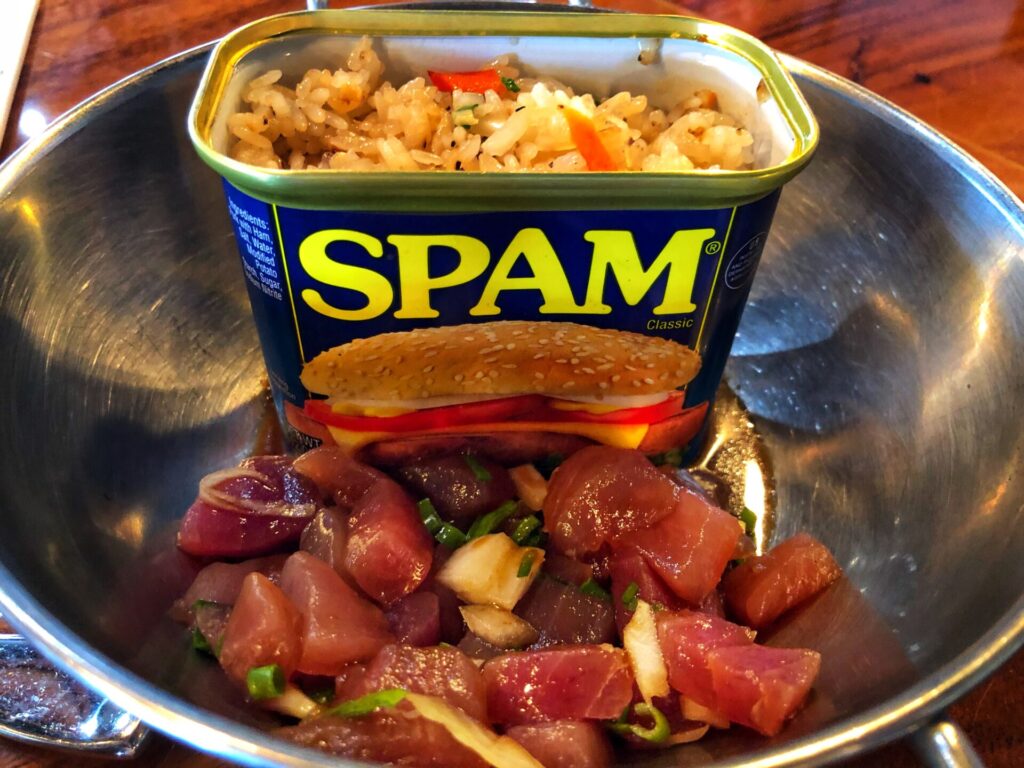 First off, Hawaiian food? There are a number of dishes that are truly Hawaiian, but not all of them are things you’ll find in restaurants. (I’ll get into a few of the authentic dishes below.) Hawaiian cuisine has morphed into a fusion of styles that is generally known as “local cuisine”, but the definition of local food is tricky. It’s like a big, happy mix of different cultures. Basically, local food combines Native Hawaiian, Japanese, Chinese, Korean, Portuguese and Filipino and is (not surprisingly) eaten mainly by locals. It’s like each dish tells a story of the island’s diverse history and the people who call it home.
First off, Hawaiian food? There are a number of dishes that are truly Hawaiian, but not all of them are things you’ll find in restaurants. (I’ll get into a few of the authentic dishes below.) Hawaiian cuisine has morphed into a fusion of styles that is generally known as “local cuisine”, but the definition of local food is tricky. It’s like a big, happy mix of different cultures. Basically, local food combines Native Hawaiian, Japanese, Chinese, Korean, Portuguese and Filipino and is (not surprisingly) eaten mainly by locals. It’s like each dish tells a story of the island’s diverse history and the people who call it home.
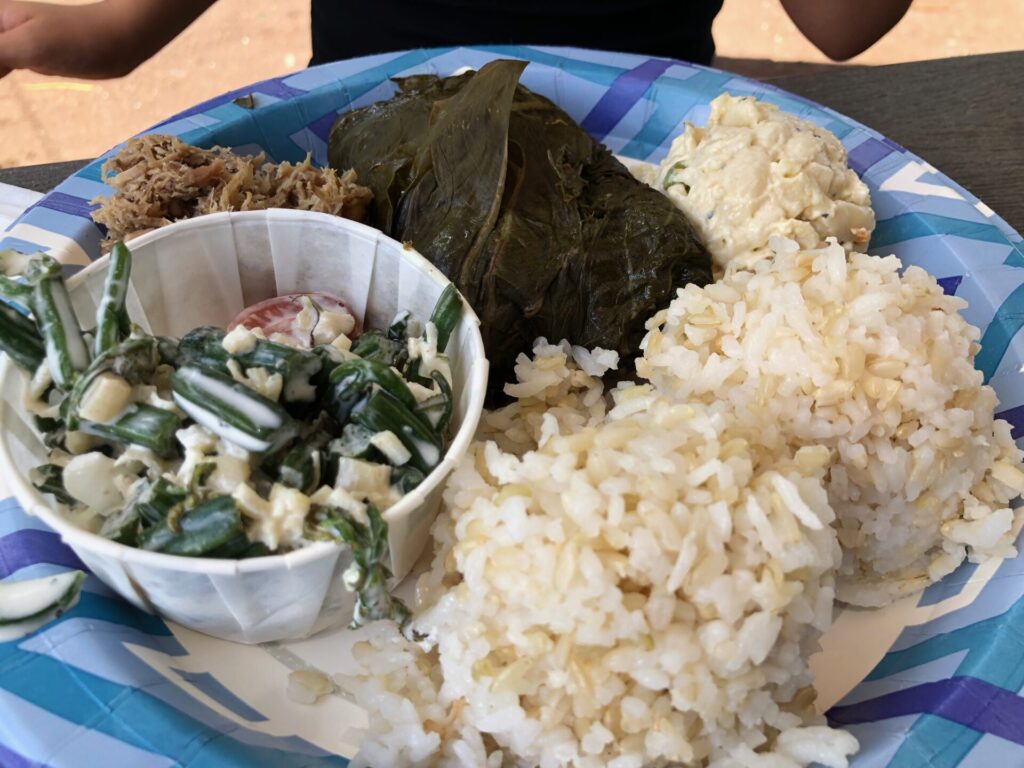 If it’s truly authentically Hawaiian dishes you’re looking for, there’s a few dishes to keep an eye out for. Poi is probably the most recognizable you’ll need to an eye out for. It’s steamed taro root pounded into a paste and allowed to ferment slightly. The more sour it is, the more it’s been allowed to ferment and it’s usually only the real old timers that like their poi real sour. It’s considered a superfood, being packed with potassium, vitamin C, magnesium and iron. The poi served at lu‘au isn’t usually the best quality. (Which might be why so many visitors think it’s not good, and since few people hardly try it and it will be thrown out at the end of the night, the caterers will only serve poor quality poi—and the vicious cycle continues.) For what it’s worth, my favorite poi is Hanalei Poi from Kaua‘i and it can be found in many stores (even Costco here). Another truly Hawaiian dish is laulau. You’ll see it in some restaurants, but it’s the homemade stuff that you find at fundraisers and roadside stands that those from Hawaii go wild for. It’s a relatively complex dish that traditionally uses pork and fish (and usually a miso marinated, butterfish/black cod), starchy vegetables such as kalo, purple sweet potatoes and/or breadfruit, that is then wrapped in a taro leaf (which is somewhat similar in taste and texture to a collard green after it’s been thoroughly cooked), and then wrapped in a ti leaf (the same plant used for non-floral leis) and steamed. You eat everything except the ti leaf wrapping—that seals in the moisture. There are a lot of variations, such as chicken, beef and vegan styles. When it’s done right, it’s down right addicting.
If it’s truly authentically Hawaiian dishes you’re looking for, there’s a few dishes to keep an eye out for. Poi is probably the most recognizable you’ll need to an eye out for. It’s steamed taro root pounded into a paste and allowed to ferment slightly. The more sour it is, the more it’s been allowed to ferment and it’s usually only the real old timers that like their poi real sour. It’s considered a superfood, being packed with potassium, vitamin C, magnesium and iron. The poi served at lu‘au isn’t usually the best quality. (Which might be why so many visitors think it’s not good, and since few people hardly try it and it will be thrown out at the end of the night, the caterers will only serve poor quality poi—and the vicious cycle continues.) For what it’s worth, my favorite poi is Hanalei Poi from Kaua‘i and it can be found in many stores (even Costco here). Another truly Hawaiian dish is laulau. You’ll see it in some restaurants, but it’s the homemade stuff that you find at fundraisers and roadside stands that those from Hawaii go wild for. It’s a relatively complex dish that traditionally uses pork and fish (and usually a miso marinated, butterfish/black cod), starchy vegetables such as kalo, purple sweet potatoes and/or breadfruit, that is then wrapped in a taro leaf (which is somewhat similar in taste and texture to a collard green after it’s been thoroughly cooked), and then wrapped in a ti leaf (the same plant used for non-floral leis) and steamed. You eat everything except the ti leaf wrapping—that seals in the moisture. There are a lot of variations, such as chicken, beef and vegan styles. When it’s done right, it’s down right addicting.
Poke: More Than Just Raw Fish
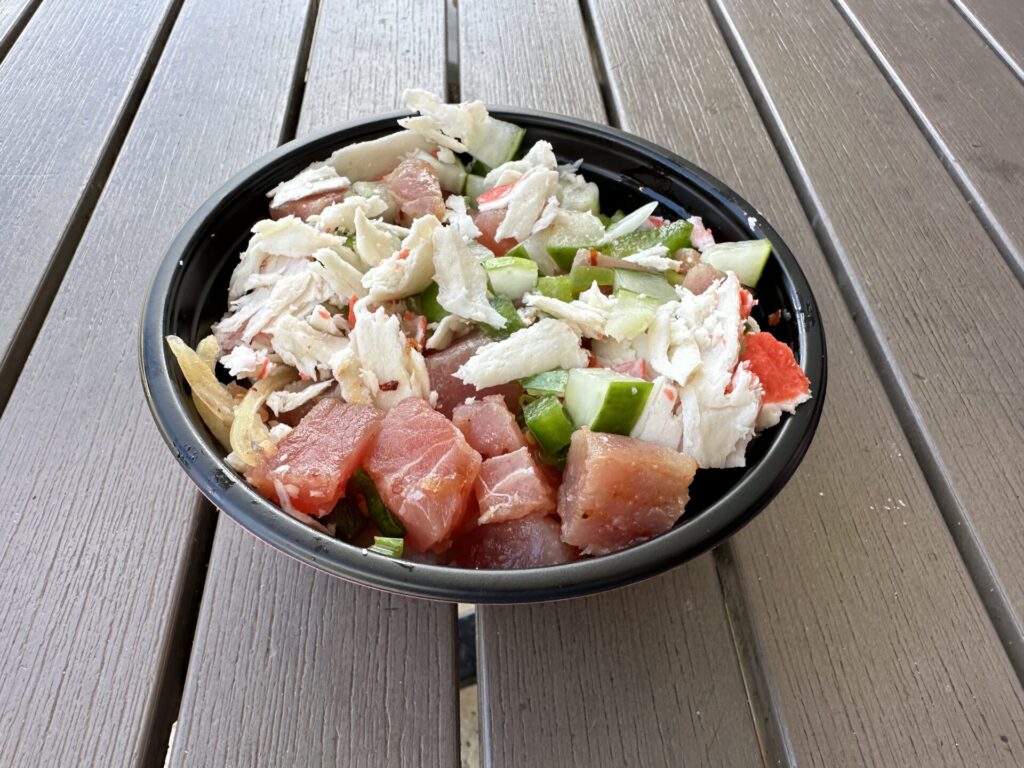 You’ve heard of poke, right? No, not the Facebook kind. It’s this amazing dish of cubed raw fish, seasoned in all sorts of ways. Think soy sauce, sesame oil, green onions, and sometimes a kick of chili. It’s not just sushi in a bowl – it’s a flavor explosion! The varieties are seemingly endless—‘ahi tuna is the most commonly used fish, but really any type can be used. Non-fish poke, such as crab, shrimp and octopus is also really popular. Spicy poke uses a mix of mayonnaise and sriracha hot sauce to make for a creamy concoction that’s hard to beat. (Mayo and raw fish sounds like it would be a disaster, but it works.) Hawaiian style includes seaweed (called limu in Hawaiian) and ground up kukui nuts (also called “candlenut”—ancient Hawaiians used them as candles thanks to their extremely high amount of oil.) Even edamame (soy beans) are better with poke seasoning. And for the record, it’s pronounced PO-kay, not PO-kee.
You’ve heard of poke, right? No, not the Facebook kind. It’s this amazing dish of cubed raw fish, seasoned in all sorts of ways. Think soy sauce, sesame oil, green onions, and sometimes a kick of chili. It’s not just sushi in a bowl – it’s a flavor explosion! The varieties are seemingly endless—‘ahi tuna is the most commonly used fish, but really any type can be used. Non-fish poke, such as crab, shrimp and octopus is also really popular. Spicy poke uses a mix of mayonnaise and sriracha hot sauce to make for a creamy concoction that’s hard to beat. (Mayo and raw fish sounds like it would be a disaster, but it works.) Hawaiian style includes seaweed (called limu in Hawaiian) and ground up kukui nuts (also called “candlenut”—ancient Hawaiians used them as candles thanks to their extremely high amount of oil.) Even edamame (soy beans) are better with poke seasoning. And for the record, it’s pronounced PO-kay, not PO-kee.
While I think it’s best served as is, it becomes a full meal if done as a poke bowl. This just means that it’s served atop rice. If you get a poke bowl, especially to go, keep in mind the rice is served hot. The heat from the rice can quickly make the poke less fresh tasting, and depending on how long you’re transporting it, could lead to other issues. While poke is served in many restaurants, usually on the appetizer list (also called “pupus” here), the best I know of comes from the counter in the grocery stores or from shops that specialize in poke.
The Legendary Plate Lunch
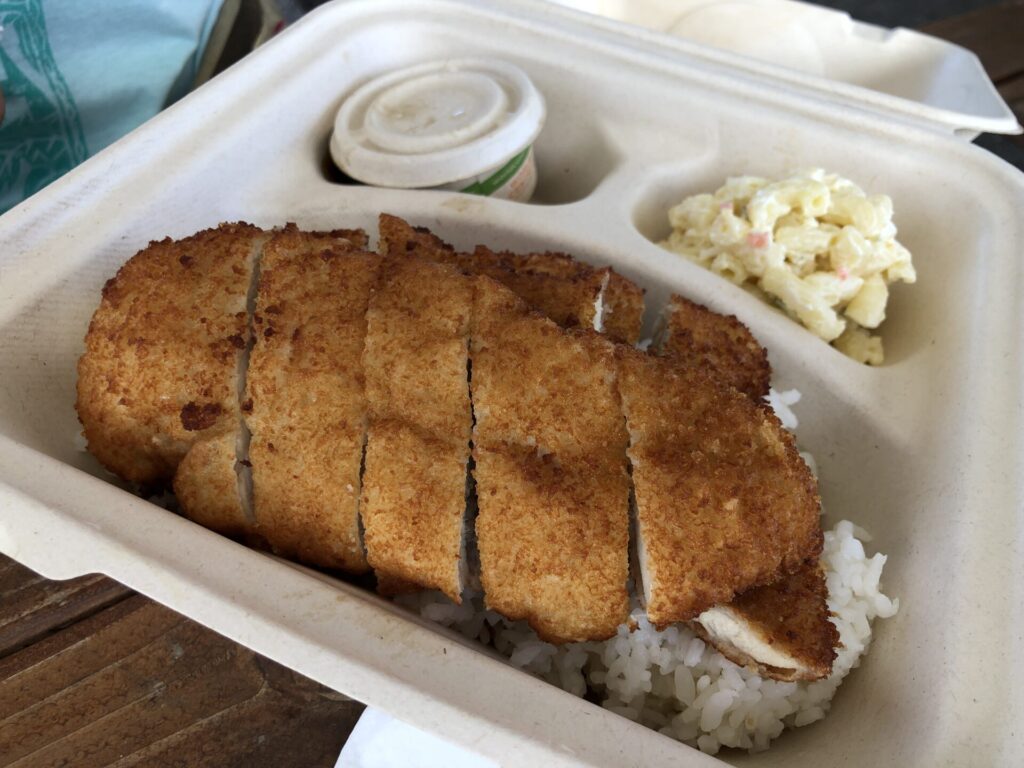 Now, let me introduce you to the plate lunch. This isn’t just a meal; it’s an experience. Picture this: two scoops of rice, a scoop of creamy macaroni salad, and a generous serving of something delicious like teriyaki chicken, kalua pork, or beef stew. This type of meal really encapsulates the melting pot of Hawaii cuisine. Originating during the plantation days, you can almost see the sharing and trading of lunches that occurred between the various ethnic groups when they all ate together during breaks. The plate lunch combines the compartmentalized presentation of a bento box (Japan), the necessity of carbs in the form of rice (China and other Asian cultures), a hearty and savory protein such as beef stew (Portuguese), plus a side that blends a number of cheap staples together in the form of macaroni and/or potato salad (American). It’s comfort food, Hawaiian style.
Now, let me introduce you to the plate lunch. This isn’t just a meal; it’s an experience. Picture this: two scoops of rice, a scoop of creamy macaroni salad, and a generous serving of something delicious like teriyaki chicken, kalua pork, or beef stew. This type of meal really encapsulates the melting pot of Hawaii cuisine. Originating during the plantation days, you can almost see the sharing and trading of lunches that occurred between the various ethnic groups when they all ate together during breaks. The plate lunch combines the compartmentalized presentation of a bento box (Japan), the necessity of carbs in the form of rice (China and other Asian cultures), a hearty and savory protein such as beef stew (Portuguese), plus a side that blends a number of cheap staples together in the form of macaroni and/or potato salad (American). It’s comfort food, Hawaiian style.
Kalua Pork: The Star of Luau
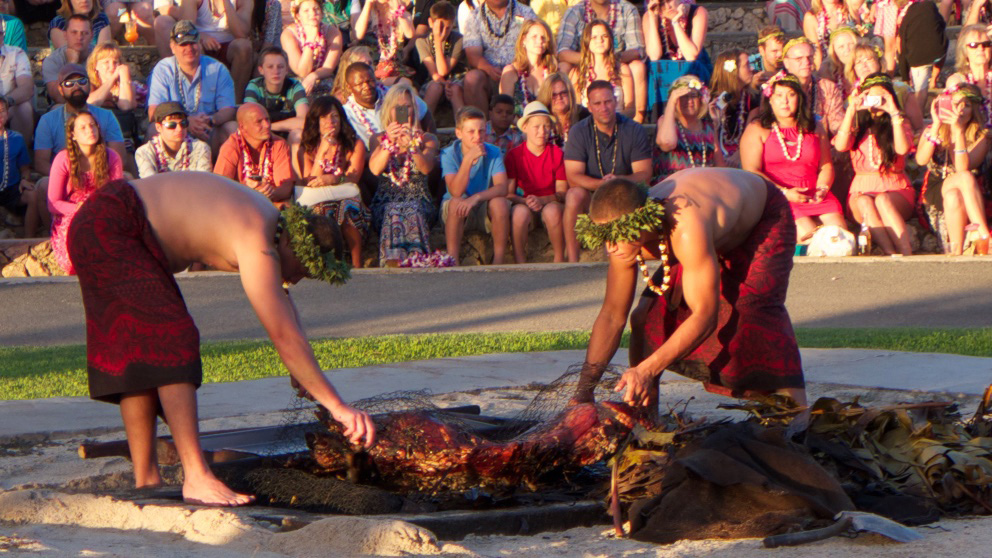 Speaking of kalua pork, it’s the star at any lu‘au. This succulent, smoky pork is cooked in an underground oven called an imu. The whole pig is well salted (Hawaii has fantastic salt from evaporated sea water—in the fact the Hawaiian name “pa‘akai” literally means “hardened salt water”), wrapped in banana leaves, buried and left to cook all day long. Many lu‘au include the unearthing of the kalua pig as part of the whole ceremony. No matter how many times I’ve seen it, I still get excited for the imu ceremony. (Though all my experience has also taught me to look closely—the pig they take out of the imu isn’t always the one you eat. I’ve even caught one company using a plastic pig!) Theatrics aside, what is the result? Tender, flavorful meat that literally melts in your mouth. Pair it with some poi (a traditional Hawaiian staple made from taro), and you’re in Hawaiian food heaven. If you want to try it at home, I even have a slow cooker recipe for kalua pork so you can have taste of the islands at home.
Speaking of kalua pork, it’s the star at any lu‘au. This succulent, smoky pork is cooked in an underground oven called an imu. The whole pig is well salted (Hawaii has fantastic salt from evaporated sea water—in the fact the Hawaiian name “pa‘akai” literally means “hardened salt water”), wrapped in banana leaves, buried and left to cook all day long. Many lu‘au include the unearthing of the kalua pig as part of the whole ceremony. No matter how many times I’ve seen it, I still get excited for the imu ceremony. (Though all my experience has also taught me to look closely—the pig they take out of the imu isn’t always the one you eat. I’ve even caught one company using a plastic pig!) Theatrics aside, what is the result? Tender, flavorful meat that literally melts in your mouth. Pair it with some poi (a traditional Hawaiian staple made from taro), and you’re in Hawaiian food heaven. If you want to try it at home, I even have a slow cooker recipe for kalua pork so you can have taste of the islands at home.
Find all the best (and avoid the worst) restaurants, activities and experiences in Hawaii with our guides. Our believable guides will help you have an unbelievable vacation in the Hawaiian Islands and beyond.




0 Comments